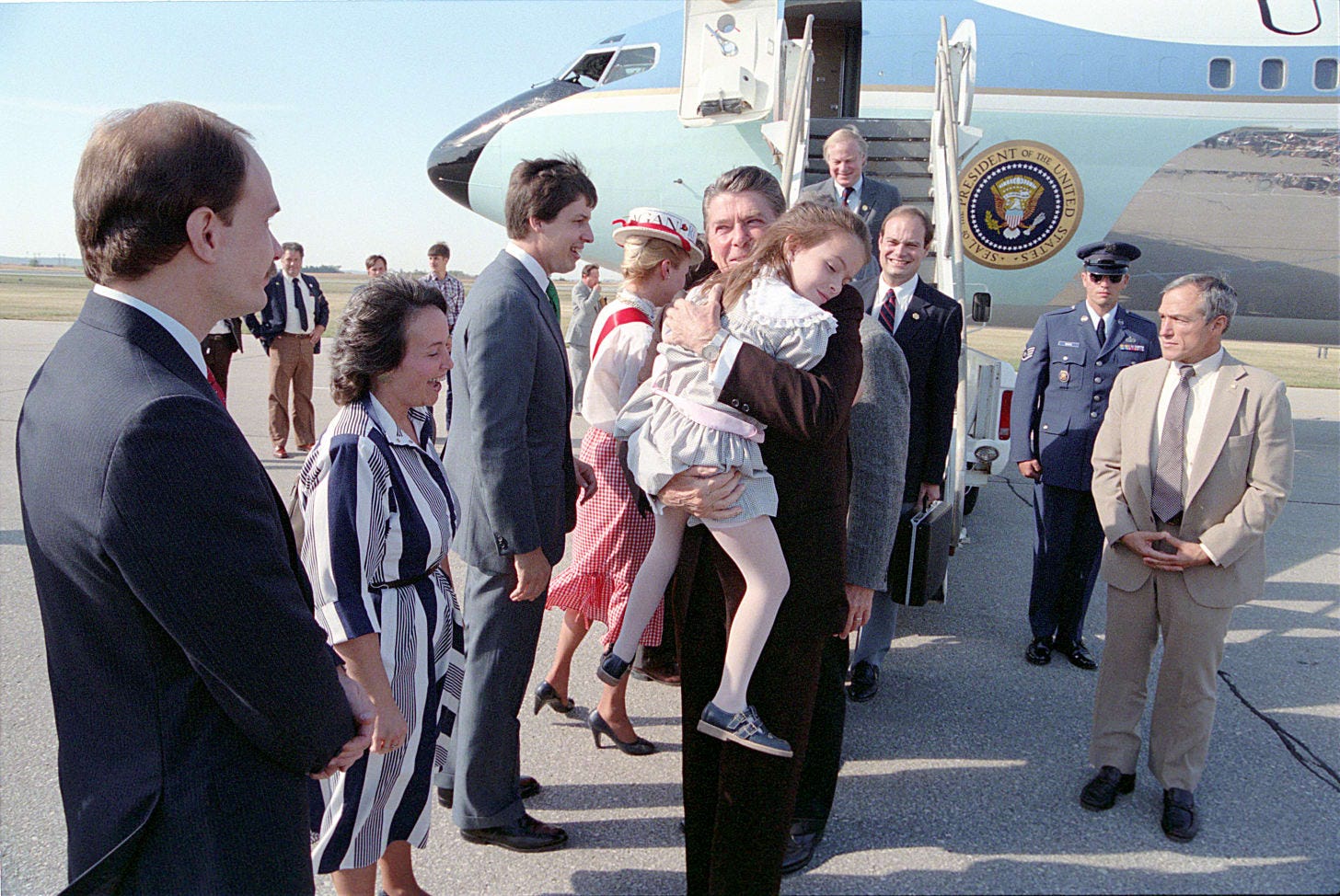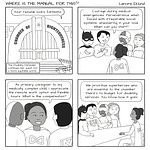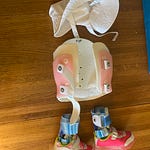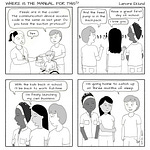
Medicaid would have paid for Katie Beckett to live her entire life in a hospital.
Her mom, Julie Beckett, had other ideas.
Not only would that have been a waste of government resources, but a poor excuse for a childhood. So Julie Beckett collected arguments and data and took her advocacy all the way to President Ronald Reagan. Within two days of the President speaking about this, administrators made an exception for Katie. Soon after, there was an option for states to create what became known as “Katie Beckett waivers,” that would allow funding for disabled children to be raised at home.
Julie Beckett died in May 2022 at the age of 72, according to her New York Times obituary. Her daughter passed away in 2012 but lived to the age of 34 — her prognosis vastly improved by living at home.
The Times obituary credits the Beckett women’s advocacy with liberating hundreds of thousands of children from the path of institutionalization.
Though she was widely regarded as one of the most significant figures in the history of the disability rights movement, Ms. Beckett insisted that she was simply looking out for her daughter, and that everything flowed from there.
“There comes a moment in parenting,” she wrote in 2017, “where you discover strength you didn’t know you had — all because your child needs you.”
There are many things I wish I could have asked Julie Beckett, but one of my biggest questions is how she felt about the confusing patchwork of Medicaid systems we now have throughout the country.
Though many states have some form of a “Katie Beckett” program, no state’s children’s services program looks the same and not all children who qualify get access. There is an entire website dedicated to the many ins and outs in each of the 50 states’ waivers as relates to children.
Complaints of over-complexity abound. Here’s a recent article from disgruntled parents in Tennessee. Some states, like Nebraska or Oklahoma, are only just now getting around to cutting down years’ long waitlists for children. Others? Aren’t even trying.
Some states give parents a set budget that they can use to direct care for their child while others make them employers of in-home caregivers. (This is also true for disabled adults or their representatives but here I’m focusing on how these programs work for kids, who always have a legal guardian directing care.)
Some states, like Colorado and now Arizona, have programs that will allow parents to be paid as their own child’s support worker.
The complexity is so great that even many of the people working in these systems don’t understand them.
In Oregon, as I have researched how to create a paid parent-caregiver program, I have heard several times that the federal government does not allow parents to be paid caregivers under our state’s waivers.
So, I asked the Centers for Medicare and Medicaid Services (CMS) what they thought. In fact, they said there are several different ways the federal government allows for this freedom.
But first. In order for you to understand their answers, I have to explain the different types of children’s services waivers. Instead of a comprehensive, rational program that applies to every American child, we have several limited, idiosyncratic solutions for various constituencies, even within the same state. There are easily hundreds of different buckets of Medicaid money for disabled children across the nation.
Let’s start with what Medicaid is. Medicaid was started in the 1960s as public health insurance for low-income Americans. What many people don’t realize today is that both Medicaid and Medicare (which is for the elderly) are under the Social Security umbrella.
On the most basic level, the change that Julie Beckett was made famous for was enabling her daughter to qualify for Medicaid even though the Becketts were not poor. (The dual-income household had, however, exhausted their private insurance and the only option for Katie would have been to live in a Medicaid-funded institution.) In Katie Beckett waivers — which were actually created and funded through a 1982 tax act — disabled children qualify based on their own resources and incomes, not that of their parents.
Soon after, Congress created Section 1915 (c) of the Social Security Act. That created what’s called Medicaid’s Home and Community Based Services (HCBS) and there are now four different types of waivers for that: Section 1915 (c), Section 1915 (i), Section 1915 (j) and Section 1915 (k). All four of those offer “self-direction options” — thus labeled because beneficiaries, rather than institutions, get to choose how they spend the Medicaid money.
If that weren’t confusing enough, there are also Section 1115 waivers that give states Medicaid money to play around with to develop pilot or experimental health care projects.
There are pros and cons to each of the above six different types of funding that can be used for disabled children’s in-home services. There are other smaller programs, too, but I’m going to stop there. (If you want to dive deep, here is a primer on HCBS.)
In my state, Oregon, we have three different 1915 (c) waivers, a 1915 (k) waiver, a 1915 (i) wavier and a 1115 waiver. We also have a 1915 (j) waiver, but ours does not apply to children.
Get all that? Great. Now you might have a chance of understanding the answers CMS gave me. First, most of Oregon’s children’s services are funded through 1915 (k) — what we call the “K-plan.”
“Medicaid self-direction authorities allow legally responsible family members to be paid providers,” a CMS spokesperson, who for some reason did not want to be identified by name, wrote to me. “Under 1915(k) of the Social Security Act (the Act), family members can be paid providers as long as they do not act as the beneficiary’s representative for 1915(k) related activities such as the person-centered planning process.”
So all four of the “self-direction” plans can allow parents to be paid providers, if states so choose.
There was a temporary change made during the pandemic’s public health emergency. The federal government loosened its restriction on the legal guardian for the child; that person could also be a paid provider.
This was already the case, however, for 1915 (c) and (i) waiver programs.
“For both 1915(c) and 1915(i) HCBS authorities, a state may allow legally responsible relatives (including parents) to be paid to provide HCBS services in extraordinary circumstances such as when another provider is unavailable,” the CMS spokesperson said. “Each state defines the extraordinary circumstances in which legally responsible individuals may become paid workers. This provision is usually used with individuals who require a provider with particular skills, such as behavioral interventions. It is also used in rural areas that have provider shortages or during emergencies such as the COVID-19 pandemic or a natural disaster.”
Some people may argue that parents shouldn’t be paid for the care of their own children, or that the childcare crisis is affecting all parents. Personally, I would agree that all U.S. parents need vastly more support and funding than they get. But it is important to note that we are not talking about subsidizing homemakers or paying parents for childcare. These are jobs with hours and wages and identified tasks that go above and beyond “ordinary” parenting. Caregiving is not the same thing as parenting.
“Even in extraordinary circumstances, for children, the parent or legally responsible relative may be paid to provide only those services in addition to what a child of the same age without a disability requires and which are necessary to assure the health and welfare of the child,” CMS said.
CMS gave me much more information on the options for states to pay family members, including parents, but it gets even more technical and I don’t want to bore you. For those interested, here is a link to the full Q&A.
The bottom line?
“…there is no federal policy that would preclude a family member from providing services they are qualified to provide,” CMS said.
So why aren’t paid parent-caregivers a standard option yet? Not just in Oregon, but throughout the country?
Personally, I see a thread through Julie Beckett’s advocacy to today. What I see — from the creation of institutions, to the rise of complex bureaucracies, all the way to the resistance to paying parents as caregivers — is a prejudice. Too many believe that parents are just too incompetent and society needs to create some sort of expensive third-party system to control the care of their disabled children.
It seems we to have to keep proving them wrong, generation after generation.
NOTE: A version of this story ran on May 29, 2022.
Medical Motherhood’s news round up
Snippets of news and opinion from outlets around the world. Click the links for the full story.
• From California Health News via Disability Scoop: “Nursing Shortage Puts Children With Disabilities At Risk, Spurs Calls For Change”
SACRAMENTO, Calif. — Analicia Brokloff just wanted to take her daughter home. Her 2-year-old, Mila, was ready to be discharged from UC Davis Children’s Hospital in Sacramento after having a lung infection.
Mila, who has cerebral palsy, still required the care of a home nurse, as she recovered last fall from having a tracheotomy — a surgical opening in the throat to help her breath.
But there were no home nurses available. So, due to staffing shortages and cracks in the health care system — but not due to medical need — Mila had to stay in the hospital. It had been two weeks since she was well enough to go home. She’d arrived in the hospital close to two months ago, and her family and the hospital discharge planner had been searching for a home nurse the whole time.
“It was just really hard,” said Brokloff. “It feels like (children with disabilities) and their parents are falling through the cracks.”
Finding nurses to care for medically fragile children at home has historically been difficult. But since the start of the COVID-19 pandemic, the problem has worsened dramatically, according to parents of children with disabilities and home health agencies. The pandemic set off a surge in demand for nurses at hospitals, clinics and other health care facilities, and widened the compensation gap between these and lower-paid home nursing jobs. This pulled nurses away from home care. At the same time, large numbers of nurses left the profession — many due to health concerns, retirement and burnout — shrinking the overall workforce. As a result, fulfilling requests for home nurses has become close to impossible, those in the field said. That’s especially true for the more than 1 in 4 California children with special health care needs who, like Mila, are insured through the state’s public health insurance program, Medi-Cal, which typically pays nurses less than private insurance.
“It’s worse than ever, it really is,” said Dean Chalios, president and chief executive officer of the California Association for Health Services at Home.
To solve the issue, the association is calling on California’s governor and legislature to increase Medi-Cal reimbursement rates for home nurses by 40% in next fiscal year’s budget. Chalios said a rate increase would make pay for home nursing more competitive and attract people back to the field. It would also save the government money, he said, by keeping medically fragile children out of hospitals and nursing facilities. Both are more expensive than caring for children at home.[…]
• From Healthnews: “Changing Spaces for People With Disabilities: Where to Find Them?”
[…]Disabled children, adolescents, and adults — over the height and weight limits of baby changing tables — requiring help with toileting cannot use regular handicapped-accessible bathrooms. Instead, there must be a choice to stay home from public spaces, be laid down on a restroom floor to be changed by their caregiver, or leave the public place or event as soon as they need the restroom to be changed inside a vehicle or return home.
Universal changing spaces have height-adjustable, adult-size changing tables that accommodate everyone. These are necessary for public areas such as restaurants, hotels, venues, movie theaters, and zoos so that disabled individuals can have equal opportunities to engage in activities and travel.
All disabled Americans deserve a safe, private, and dignified changing space.
Several states are working to include this population segment in community activities and public spaces. According to the National Aging and Disability Transportation Center (NADTC), California, Arizona, Michigan, and Pennsylvania have enacted legislation for universal changing spaces in public spaces and accommodations. In addition, a few other states have introduced legislation to be considered by state lawmakers.[…]
• From the Deccan Chronicle: “Procter & Gamble India launches ‘Lead With Care’ for employees
HYDERABAD: Procter & Gamble India on Wednesday announced “Lead With Care” programme, which offers a holistic support to employees who are caregivers to children with disabilities and special needs.
Effective from April 1, the programme will enable employees to avail early care and treatment for children impacted by specific neurodevelopmental, cognitive, behavioral, or physical impairments. It will also include medical coverage across diagnosis, doctor consultations, treatment, cost of medicines and devices, and builds on top of the existing medical support the company extends to all its employees and their families, including employees of the LGBTQ+ community.
The Company will further facilitate specialized and trained day-care support via certified partners and shall provide an employee assistance program (EAP) available 24x7 to all employees and their families to navigate this journey.[…]
Medical Motherhood brings you quality news and information each Sunday for raising disabled and neurodivergent children. Get it delivered to your inbox each week or give a gift subscription. Subscriptions are free, with optional tiers of support. Thank you to our paid subscribers!
Follow Medical Motherhood on Facebook, Twitter, TikTok, Instagram or Pinterest. The podcast is also available in your feeds on Spotify and Apple Podcasts. Visit the Medical Motherhood merchandise store.
Do you have a story to share or an injustice that needs investigation? Tell me about it and it may become a future issue.












